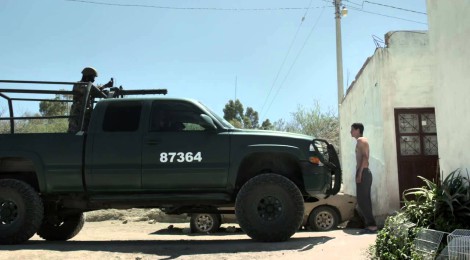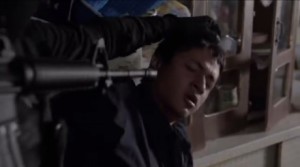
Violence as narrative function or, some thoughts on why HELI divides critics
Mediático presents an entry by Dr Niamh Thornton, Senior Lecturer in Latin American Studies at the University of Liverpool. Her key area of research is Mexico and the war story. Her recent publications are Revolution and Rebellion in Mexican Cinema (New York: Bloomsbury, 2013) and an edited volume with Catherine Leen International Perspectives on Chicana/o Studies: This World is My Place (New York & London: Routledge, 2013). She has also published on literature, digital cultures, Star studies and fan videos. Her research website is here.
By Niamh Thornton
Foremost in reviews of Heli (Amat Escalante, 2013) is the film’s violence. On its Cannes premiere, negative and positive reviewers alike based their assessment on its ability to convince with its realism, and on whether the torture scene at its centre is justified and/or realistic. Like Escalante’s previous feature film, Los Bastardos (2008), Heli is slow moving. Violence when it happens does so at a pace that appears mundane, sudden, and banal. Like the reviewers, I have just used violence here to mean the explicit enactment of physical brutality by one human on another, the portrayal of which is frequently a controversial field in cinema, but difficult to define or delimit. What makes a violent film is often subjective – that is, what the viewer’s level of tolerance is towards it – and value judgements arise which lay claim to objectivity over whether it appears gratuitous, in other words, superfluous to the plot and thereby lacking narrative function. So, does Heli pass muster?
In some ways my question is mischievous. The torture scene is central to the plot, but is not the central concern of the film. The character Heli (Armando Espitia) is witness to the torture; he is present in the room when his sister’s boyfriend, Beto (Juan Eduardo Palacios), is beaten and his genitals are set alight. As well as the subsequent savage beating he receives, part of the torture for Heli is the enforced witnessing of Beto’s torture, and the fear that the same will be done to him. As a consequence, the film is concerned with the fall out from this event on him and those around him, and his sister’s disappearance.
Heli is about structural violence and the banality of evil (to use Hannah Arendt’s term). The violence we see is manifold. It is that of working in a company that has no duty of care towards the workers other than to make them productive and to discard them when they fail to match that promise. This is the numbing nature of this latest iteration of capitalism as it manifests itself on the border between the US and Mexico. It is also the terrible consequences of state violence, in particular a form that is supported by transnational actors and co-opts the young to partake in it, and, most chilling of all, it is the violence implicit in the absence of justice. While many of the reviewers note that this is a central concern of the film, they do not name this as violence.
The physically enacted violence is what captures attention and its banality disturbs, alienates or disgusts reviewers. Why is this so? It is not because it is not realistic.[1. For more on slow cinema and realism, in particular on Carlos Reygadas, Escalante’s mentor, see, Tiago de Luca, Realism of the Senses in World Cinema IB Tauris, 2013 ] Unfortunately, it would be easy to find examples of similar and worse real life cases of torture that have been carried out in the last few years in Northern Mexico. Dismembered and tortured bodies hung off bridges became a regular feature in some areas. The banal nature of the violence is what disturbs.
In Heli, the torture takes place in a room where people are lounging casually. It has a bed, sofa, chairs, a television and a video console. Children are playing on the console. Beto and Heli are brought into the room and the children stop playing to watch, dispassionately. The continuum between the gameplay and the torture is underlined through the score. A videogame theme (“Game Theme Tucha Tucha”) plays on a loop as part of the diegesis. One of the children is encouraged to hit Heli in what is evidently a type of training. The camera cuts between wide shots of Beto being beaten, reverse shots, alternatively, of Heli and the children watching. The scene is slow and sustained, showing us the body being tortured and rarely the torturer. This focus on the tortured body, in itself, is unsettling. The music is repetitive, sombre, and irritating, further adding to both the tension and the unsettling nature of the scene. In themselves, these elements and our identification with Heli through point of view shots and narrative development thus far, would be sufficient to make this moment terrible. But, the inclusion of the children and their involvement in the torture as a banal moment in their lives, completes the sense of disgust at what is taking place. This is not violence for entertainment, but to horrify.
Those critics (for example, here and here) who felt that the violence is excessive compare Heli unfavourably to other films that deal with the erroneously called ‘Narco violence’ (where ‘Narco’ suggests drug dealers are to blame for all of the terror, many films make it explicit that the police or the army are also implicated), as if there are a limited number of true versions and ways of portraying what has been happening in parts of Mexico in recent years. Interestingly, more often than not, the film the critics preferred is Miss Bala (Gerardo Naranjo, 2011), one whose violence takes place in bursts of action, uses dramatic set pieces, explosive firearm attacks, and the terror of a woman in rather conventional ways (see my discussion of these choices here). Action is at the centre of the narrative, whose function is to follow how tensions come to a dramatic end. This fast-paced technique lead to greater critical consensus. In contrast, Escalante makes violence and its multiple manifestations the subject of the narrative in ways that disturb, disrupt convention, and challenge the viewer by distancing them from the pleasures of viewing violence.
For me, Escalante may make missteps in his cinematic output in relation to the troubling patterns in his representation of women, but, where violence is concerned, his films are carving out an alternative to the specularization of violence and allowing space for reflection on the more complex geo-political and societal problems which have led to the horrors that have taken place in recent years in Mexico.







